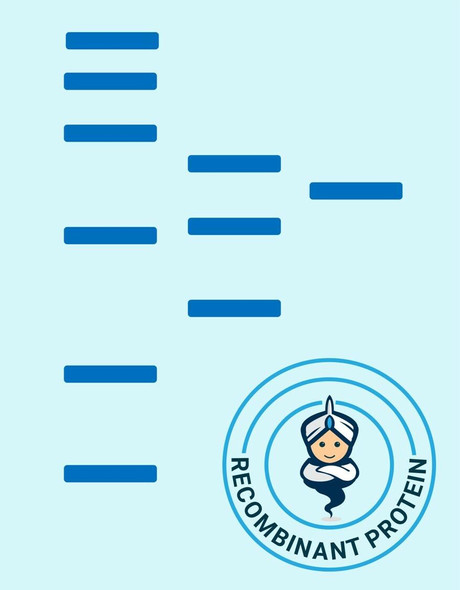Description
| Product Name: | Human TARC Recombinant Protein |
| Product Code: | RPPB1259 |
| Size: | 20µg |
| Species: | Human |
| Target: | TARC |
| Synonyms: | C-C motif chemokine 17, Small-inducible cytokine A17, Thymus and activation-regulated chemokine, CC chemokine TARC, ABCD-2, CCL17, CCL-17, SCYA17, TARC, A-152E5.3, MGC138271, MGC138273. |
| Source: | Escherichia Coli |
| Physical Appearance: | Sterile Filtered White lyophilized (freeze-dried) powder. |
| Formulation: | The protein was lyophilized from a concentrated (0.5mg/ml) solution containing 20mM PBS & 150mM NaCl pH-7.4. |
| Solubility: | It is recommended to reconstitute the lyophilized CCL17 in sterile 18M?-cm H2O not less than 100�g/ml, which can then be further diluted to other aqueous solutions. |
| Stability: | Lyophilized TARC although stable at room temperature for 3 weeks, should be stored desiccated below -18°C. Upon reconstitution TARC should be stored at 4°C between 2-7 days and for future use below -18°C.For long term storage it is recommended to add a carrier protein (0.1% HSA or BSA).Please prevent freeze-thaw cycles. |
| Purity: | Greater than 97.0% as determined by:(a) Analysis by RP-HPLC.(b) Analysis by SDS-PAGE. |
| Amino Acid Sequence: | ARGTNVGRECCLEYFKGAIPLRKLKTWYQTSEDCSRDAIVFVTVQGRAICSDPNNK RVKNAVKYLQSLERS |
| Biological Activity: | Determined by its ability to chemoattract human T-Lymphocytes using a concentration range of 1.0-10.0 ng/ml corresponding to a Specific Activity of 100,000-1,000,000IU/mg. |
TARC cDNA encodes a 94 amino acid precursor protein with a 23 amino acid residue signal peptide that is cleaved off to generate the 71 amino acid residue mature secreted protein. Along with CC chemokine family members, CCL-17 has approximately 24-29% amino acid sequence identity with RANTES, MIP-1a, MIP-1b, MCP-1, MCP-2, MCP-3 and I-309. TARC is expressed in thymus, and at a lower level in the lung, colon, and small intestine. TARC is in addition transiently expressed in stimulated peripheral blood mononuclear cells. Recombinant TARC has been shown to be chemotactic for T cell lines but not monocytes or neutrophils. CCL-17 was recently identified to be a specific functional ligand for CCR4, a receptor that is selectively expressed on T cells. CCL17 is one of quite a few Cys-Cys (CC) cytokine genes clustered on the q arm of chromosome 16. CCL17 shows chemotactic activity for T lymphocytes, but not monocytes or granulocytes. CCL17 binds to chemokine receptors CCR4 and CCR8. This chemokine plays important roles in T cell development in thymus as well as in trafficking and activation of mature T cells.
CCL17 Human Recombinant produced in E.Coli is a single,non-glycosylated, polypeptide chain containing 71 amino acids and having a molecular mass of 8 kDa. The TARC is purified by proprietary chromatographic techniques.
| UniProt Protein Function: | CCL17: Chemotactic factor for T-lymphocytes but not monocytes or granulocytes. May play a role in T-cell development in thymus and in trafficking and activation of mature T-cells. Binds to CCR4. Belongs to the intercrine beta (chemokine CC) family. |
| UniProt Protein Details: | Protein type:Motility/polarity/chemotaxis; Secreted; Secreted, signal peptide Chromosomal Location of Human Ortholog: 16q13 Cellular Component: extracellular space; extracellular region Molecular Function:CCR4 chemokine receptor binding; chemokine activity; receptor binding Biological Process: G-protein coupled receptor protein signaling pathway; cell-cell signaling; multicellular organismal development; immune response; chemotaxis; inflammatory response; negative regulation of myoblast differentiation |
| NCBI Summary: | This antimicrobial gene is one of several Cys-Cys (CC) cytokine genes clustered on the q arm of chromosome 16. Cytokines are a family of secreted proteins involved in immunoregulatory and inflammatory processes. The CC cytokines are proteins characterized by two adjacent cysteines. The cytokine encoded by this gene displays chemotactic activity for T lymphocytes, but not monocytes or granulocytes. The product of this gene binds to chemokine receptors CCR4 and CCR8. This chemokine plays important roles in T cell development in thymus as well as in trafficking and activation of mature T cells. [provided by RefSeq, Sep 2014] |
| UniProt Code: | Q92583 |
| NCBI GenInfo Identifier: | 3024711 |
| NCBI Gene ID: | 6361 |
| NCBI Accession: | Q92583.1 |
| UniProt Secondary Accession: | Q92583,Q2M287, A0N0Q9, |
| UniProt Related Accession: | Q92583 |
| Molecular Weight: | 10,507 Da |
| NCBI Full Name: | C-C motif chemokine 17 |
| NCBI Synonym Full Names: | chemokine (C-C motif) ligand 17 |
| NCBI Official Symbol: | CCL17�� |
| NCBI Official Synonym Symbols: | TARC; ABCD-2; SCYA17; A-152E5.3�� |
| NCBI Protein Information: | C-C motif chemokine 17; CC chemokine TARC; T cell-directed CC chemokine; small-inducible cytokine A17; thymus and activation-regulated chemokine; small inducible cytokine subfamily A (Cys-Cys), member 17 |
| UniProt Protein Name: | C-C motif chemokine 17 |
| UniProt Synonym Protein Names: | CC chemokine TARC; Small-inducible cytokine A17; Thymus and activation-regulated chemokine |
| UniProt Gene Name: | CCL17�� |
| UniProt Entry Name: | CCL17_HUMAN |










